India’s first semi-high-speed rail network: A new era for passengers
Posted: 2 May 2022 | Vinay Kumar Singh | No comments yet
With the coronavirus pandemic exacerbating various challenges for public transit systems, Vinay Kumar Singh, Managing Director of National Capital Region Transport Corporation (NCRTC), discusses how the development of India’s first semi-high-speed regional rail network, the RRTS, will be transformative for passengers and economy.
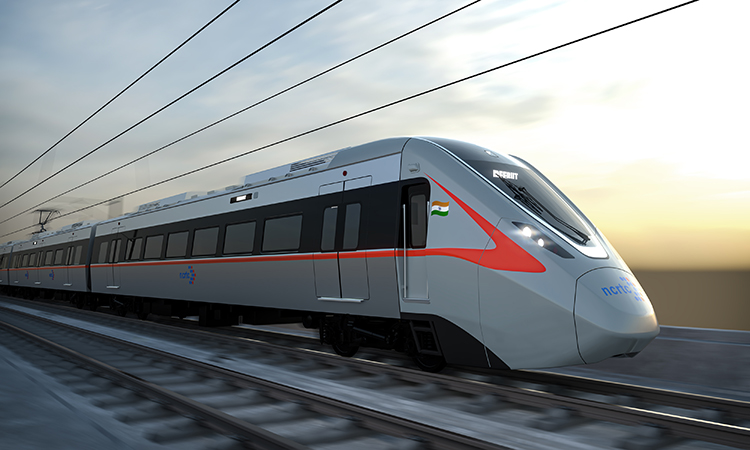

Credit: NCRTC
Over the last few years, the worldwide spread of the COVID-19 pandemic has presented unprecedented challenges for public transit systems. For developing economies like India, the success of high investment public transit systems will depend on how effectively we manage the dual challenge of affordability of services for commuters and long-term financial sustainability of projects.
In fact, the development of sustainable public transport systems will also be crucial to solve the multi-faceted problems that come with rapid urbanisation. Sustainable transit systems are designed to improve the service quality, reduce pollution, increase the efficiency of transport networks and land usage, enhance the mobility of people with reduced mobility and ensure that the public transportation stakeholders work together instead of operating in silos.
India’s urbanisation
In India, while metropolitan areas have developed well in terms of infrastructure, urbanisation has created a gap in tier two cities, where the sheer lack of opportunities, resources and transport logistics inevitably sees the population migrate, leading to congestion and immense pressure on resources.
Over the past few years, a similar phenomenon has been observed across our metro cities, which are now facing serious pressure on resources and public utilities. Although metro rail services are bringing in a modal shift towards public transport for intra-city travel, what has been missing is a high-speed, comfortable, and reliable mode of regional or intercity commute.
The RRTS: A transformative initiative
To fill this gap in regional commute and enable people to stay at urban nodes across the National Capital Region (NCR) and travel comfortably for employment, education, or healthcare, we will soon open the country’s first semi-high-speed regional rail network to the public, christened RRTS (Regional Rapid Transit System) or popularly known as ‘Regional Rail’. RRTS is a transformative initiative undertaken by the government for which the National Capital Region Transport Corporation (NCRTC) has been given the mandate to implement and operate.
For the RRTS project, we have adopted a three-pronged approach. This includes optimising CAPEX, ensuring O&M efficiency, and revenue enhancement.
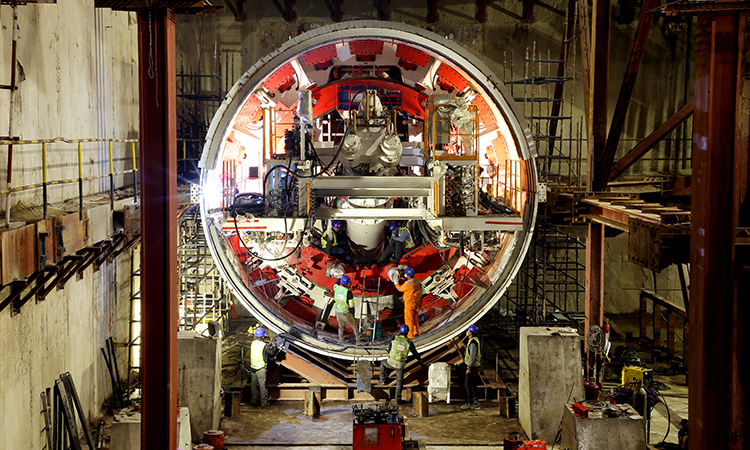

Credit: NCRTC – The tunnel boring machine at work along the RRTS corridor.
For the long-term financial viability of the project, we explored opportunities for value engineering to optimise the capital costs (CAPEX), as well as operations and maintenance (O&M) costs (OPEX). At the planning stage, we decided to look at the alignment suggested by consultants with a completely innovative approach, thereby making the three priority RRTS corridors interoperable (rather than terminating at different terminal stations in Delhi as originally planned). They will now converge at a common point i.e., Sarai Kale Khan station. This will enable common schedule of dimensions and standards across corridors, and a reduction in CAPEX in civil construction, requirement of depots and rolling stock etc. In OPEX, it will reduce energy, manpower, and maintenance cost.
This approach will also take the ease and comfort of commuters to the next level. The three priority RRTS corridors will be interoperable, meaning trains can seamlessly move from
one corridor to another, and commuters can travel from one corridor to the other, without changing trains. Furthermore, we decided to adopt European Train Control System (ETCS) Level 2 Signalling. This helped in multiple vendor compatibility, thereby creating more competition, leading to competitive pricing and easy availability of spares in the future.
At the pre-construction stage, we completed tasks such as utility shifting for handing over clear work sites to the contractors, took up risk mitigation measures for timely implementation and to avoid delays and cost escalations. We have also adopted new-age technological solutions which ensure seamless and collaborative working.
At the construction stage, we continued to challenge the status-quo for commuter comfort and optimisation of designs and capital expenditure. For instance, the optimisation of station entry and exit infrastructure considered factors such as traffic flows, availability of other modes, city and road context, and so on.
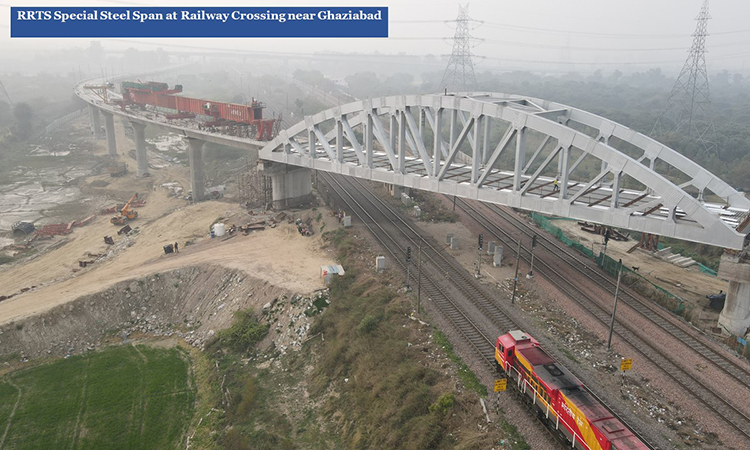

Credit: NCRTC – Steel bridge construction for the RRTS network crossing over the railway near Ghaziabad.
A noteworthy example of our value engineering initiatives for CAPEX optimisation is the decision to run the local transit services in the city of Meerut on the same infrastructure developed for the Delhi-Ghaziabad-Meerut RRTS corridor, thereby saving more than USD 800 million of public exchequer.
The Metro Rail Policy 2017, formulated by Ministry of Housing and Urban Affairs (MoHUA), India, emphasises the need for private sector participation for regional rail and metro rail projects. Also, large-scale infrastructure projects like RRTS require a large number of lower/entry level manpower at the O&M stage. We are working with leading organisations in the industry who have experience with the operations and maintenance of such systems. We will be engaging a private operator through a Public-Private-Partnership (PPP) model for utilising the expertise of the private sector and optimising the manpower cost. Furthermore, activities related to the operation and maintenance of rolling stock have been bundled on a long-term basis under the procurement package of rolling stock to the OEM.
Customer centric approach
From the very beginning, we wanted to make the project unique – not just by the sheer speed at which the trains will run – but also with modern customer centric amenities that will make it stand class apart. One of the noteworthy features is the seamless integration of the RRTS network with other modes of public transit. This is in line with our ‘Commuter First’ approach wherein RRTS stations are integrated with the Indian Railways network, metro stations, airport, and bus depots, wherever possible. Multi-modal integration of mass public transit systems will lead to the creation of a huge ‘network-of-networks’, improve ridership, and help in long-term sustenance of these highly capital-intensive projects.
From the very beginning, we wanted to make the project unique – not just by the sheer speed at which the trains will run – but also with modern customer centric amenities that will make it stand class apart.
Fare collection will be integrated with the National Common Mobility Card (NCMC) scheme started by the Hon’ble Prime Minister under the ‘One Nation One Card’ initiative. This will enable seamless travel by commuters on RRTS, metro rail and other transport systems, besides improving ridership.
For any big infrastructure project to thrive and survive, sustainability has to play a huge role, both in terms of financial sustainability and environmental factors. During O&M, the largest revenue expenditure is energy. We have decided to maximise the use of blended renewable energy to meet the full energy requirements of RRTS corridors, making it one of the most energy efficient public transit systems in the country. RRTS rolling stock will have a state-of-the-art regenerative braking system, which is expected to save up to 30 per cent of traction energy. RRTS rolling stock will also have lighting and temperature control systems to enhance the passenger experience with less energy consumption. Furthermore, we are exploring possible opportunities in electric/transformative mobility, and other alternative sources of fuels and energy. We aim to generate 11 MW renewable energy through solar panels on stations, depots, and other auxiliary buildings of the first RRTS corridor.
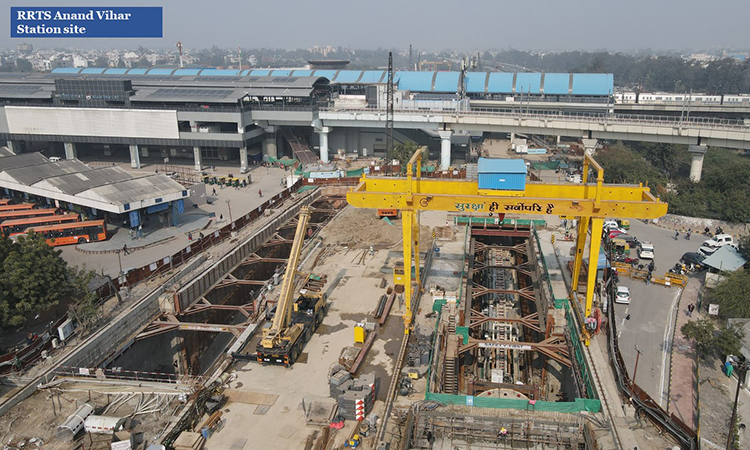

Credit: NCRTC – Construction work at the RRTS Anand Vihar station site.
We have also adopted and customised several new-age technologies which can prove revolutionary for the country’s entire rail sector. Starting with the project execution period, we have used Common Data Environment (CDE), adopted Building Information Modelling (BIM), and are also implementing a highly efficient and effective asset management system.
Our proactive efforts towards non-fare box revenue include value capture financing and transit-oriented development. Taking a cue from global case studies, where retail opportunities are identified in transport hubs it leads to improved footfalls and passenger numbers. Transit-oriented development is a novel concept in urban planning practice in the country. However, while airports have always offered shopping experiences to a captive audience, train stations have been left behind in identifying this on-site retail opportunity.
The future
Coming back to the industry-wide challenges posed by the COVID-19 pandemic, we at NCRTC were able to navigate through such difficult times as we were prepared technologically. This helped us to swiftly transition to a work from home model for all our corporate employees, while our site officers were equipped with handling the crises with the requisite support, tools, and knowledge.
Construction on the 82km-long Delhi-Ghaziabad-Meerut RRTS corridor is in full swing. The corridor will have 25 stations, including two depots and one stabling yard.
With so much innovation and energy on the ground, RRTS construction work has gathered renewed momentum as the situation starts to normalise. Construction on the 82km-long Delhi-Ghaziabad-Meerut RRTS corridor is in full swing. The corridor will have 25 stations, including two depots and one stabling yard. More than 14,000 workers and 1,100 engineers are working day and night at our sites.
The Priority Section is scheduled to be operational by March 2023, with trial runs beginning this year. The complete corridor, along with Meerut Metro services, will be opened to the public by 2025.
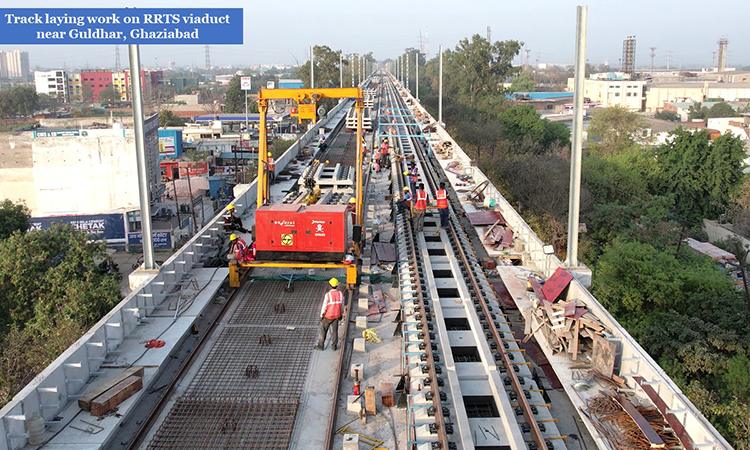

Credit: NCRTC – Track laying work on a RRTS viaduct section near Guldhar, Ghaziabad.
With RRTS, we intend to usher in a new era of how people commute between cities. Once operational, not only do we expect it to de-congest the national capital, but the first RRTS corridor will take more than 100,000 private vehicles off the roads, thereby reducing approximately 2,50,000 tonnes of carbon dioxide in vehicular emissions per year.
In the years to come, economic development will mostly be driven by a few mega-regions, like the National Capital Region (NCR) in India, which will prove to be the engines of growth for the country. To enhance productivity of the overall region, provide better access to education, healthcare, employment opportunities, affordable housing, and enable polycentric development, a total of eight RRTS corridors have been identified for NCR. The three corridors prioritised for implementation are namely Delhi-Ghaziabad-Meerut, Delhi-Panipat, and Delhi-Gurugram-SNB-Alwar.


Vinay Kumar Singh, an Indian Railway Service of Engineers (IRSE) officer, is the first Managing Director of the National Capital Region Transport Corporation (NCRTC). Since the inception of NCRTC, Vinay envisioned, planned, and is spearheading the development of an idea to reality through this $15 billion RRTS project. Prior to this, he served as the first CEO of High-Speed Rail Corporation, a subsidiary of Rail Vikas Nigam Ltd. He has extensively studied high-speed rail projects and is one of the key officers responsible for bringing high-speed rail technology to India. Vinay is a Civil Engineer and holds an M.Tech degree from the prestigious Indian Institute of Technology, Delhi. He started his professional career as a railway officer (IRSE 1988 batch). He has served in various capacities in Indian Railways, Delhi Metro, and India’s first High-Speed Rail Corporation. Vinay’s expertise lies in diligent infrastructure planning, thorough domain knowledge and pragmatic approach, with specialised focus on large-scale mass mobility projects.
Related topics
Coronavirus/COVID-19, Digitalisation, European Train Control System (ETCS), High-Speed Rail, Infrastructure Developments, Passenger Experience/Satisfaction, Route Development, Signalling, Control & Communications, Sustainability/Decarbonisation, Technology & Software, Track/Infrastructure Maintenance & Engineering








